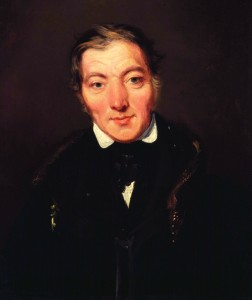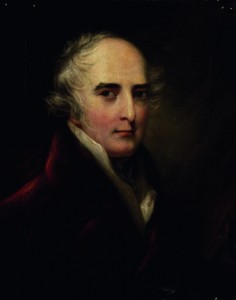‘Overwhelmed with poverty, divisions and distress’: Robert Owen’s tour of Ireland, 1822–3
Published in 18th-19th Century Social Perspectives, Features, Issue 3 (May/June 2014), Volume 22
A contemporary portrait of Robert Owen.
Robert Owen’s visit to Ireland represented an important effort to attract government support for his ‘Village Scheme’ (see sidebar). A select committee would soon meet to investigate the prevailing distress, and Owen, hoping he might give evidence, as he had on child labour, set about familiarising himself with Ireland. From October 1822 to April 1823 he toured places hit by famine and food riots and saw for himself the miserable condition of the poor and unemployed. He combined this with a major propaganda campaign, meeting local élites and speaking on public platforms.
Accompanied by Captain Donald Macdonald, a convert to Owenism, and at the outset by a Scottish laird, Archibald James Hamilton of Dalzell, who had offered land for a community, Owen crossed from Portpatrick to Donaghadee. In Belfast he attracted some useful publicity and then headed south to Dublin. From there he wrote to his wife, Caroline, saying that he had seen the lord lieutenant, Marquis Wellesley, and had spent more than an hour with him. ‘I had a very favourable hearing,’ he said, ‘he has the plan now under consideration, and I am to see him again.’ Wellesley was a powerful figure, previously ambassador to Spain before becoming foreign secretary (1809–12). Henry Goulbourn, chief secretary, had been under-secretary for war and a peace commissioner with the United States in 1814.
Name-dropper
For Wellesley and his secretary, given the concern about relief and the wider issue of Catholic emancipation, the governance of Ireland was an enormously sensitive issue and Owen’s investigations caused anxiety in official circles. The disturbances associated with distress were subjects of extensive correspondence with the Home Office during the early 1820s, and especially during Owen’s visit.
Always a great name-dropper, Owen in his letter to Caroline also mentions dining with the bishop of Down and the lord mayor, and visits to Lord Cloncurry, the duke of Leinster and the bishop of Ossory. This suggests that his reception by the élite, especially the clergy, was amicable. He also addressed Catholic divines at St Patrick’s College, Maynooth. The Catholic bishops had become reluctant converts to constitutionalism and exercised their influence against revolution fairly consistently. Endowments were made available to Maynooth from 1808, and at the time of Owen’s visit the hierarchy were pragmatically supportive of the status quo. Quite what he expected to gain from his briefing of the divines is difficult to determine, but presumably he avoided all references to the evils of sectarianism in religion.
Travels in the countryside

Richard Colley Wellesley, lord lieutenant of Ireland—given the concern about relief and the wider issue of Catholic emancipation, for Wellesley the governance of Ireland was an enormously sensitive issue and Owen’s investigations caused anxiety in official circles.
Throughout the trip he stayed with local gentry and MPs, some of whom had visited New Lanark. There were invitations to stay; someone offered the loan of a carriage and another to forward mail gratis. He wrote to followers in Scotland in effusive terms about his reception and the willingness of people to listen. How much attention he actually paid to what he saw in the countryside is difficult to assess because he tended to concentrate on his own activities and the people he met. By mid-January he was in Limerick.
There on 19 January 1823 he held a public meeting to explain his intentions. In Ireland there was on the one hand ‘an abundance of agricultural and manufactured produce’, and on the other much poverty and distress. The remedy was the village scheme and he duly exhibited a large drawing of ‘the new establishment at Motherwell near Hamilton in Scotland’, which he said ‘is to commence in the course of this year’. There were some critical questions as to how the villages would actually operate in practice. Nevertheless he was optimistic, writing enthusiastically to Hamilton that the evil intentions of old society could be turned to the advantage of the new system ‘to accomplish the most valuable purposes’. Religious antagonism could be overcome and the Scottish clergy who spoke against him would lose their influence. ‘I am prepared now to meet them on their own ground’, he told Hamilton. He claimed support for his ideas from the Irish clergy, but he was hardly challenging them on their own doorsteps, as he was the Lanark presbytery at home.
Thereafter he accompanied Sir Edward O’Brien, MP for Clare and a supporter of Catholic claims, to a session of the courts at Ennis, explaining his plan to local gentry. He then visited Tipperary and Kerry before returning east to inspect Meath, which he later cited as typical of prevailing conditions. He foolishly declared that he would divulge a ‘secret’ that would put all to rights. Quite what he meant is unclear, but it may have been contraception rather than the com-munity scheme itself. Expectations were further heightened in March–April by newspaper advertisements promoting various Owenite publications, including his essay on the distressed working classes, a report of the British and Foreign Philanthropic Society, and an Irish edition of A new view of society.
Back in Dublin to tumultuous meetings
But at the first of several meetings held in Dublin on 12 April 1823 he showed less sympathy than he might have done with the plight of Ireland and, apart from a long exposition about character formation, said that he could save the country with the village plan. Whether or not he intended to speak about alternative strategies to solve the population problem and poverty, including birth control, is unclear. He was probably confused because he was suffering from influenza and overwhelmed by the turnout. Nonetheless he caused a sensation, and the Freeman’s Journal excitedly reported a meeting where ‘an assemblage of rank, talent, fashion at the Rotunda [heard] the benevolent Mr Owen develop his plans for bettering the condition of Ireland’s miserable peasantry’. ‘The Great Round Room was thronged to excess, yet hundreds of the most respectable persons were unable to secure admission’, the report continued, and the place was so crowded that all the windows had to be opened and women helped through to ‘recover their composure’. A large painting, possibly of New Lanark or his proposed community, ‘excited general admiration’. Owing to indisposition, Owen was drained by the three-hour exposition, which left little time for reaction. Dr Charles Orpen, distinguished medical practitioner and reformer, read out the rules and regulations for a com-munity. Noting the ‘anti-Christian tendencies’ of some of the principles, he did not elaborate, realising that it would ‘only excite a tumult’ among the audience.
Clearly the response caused Owen to think twice about the next meeting. Much recovered, he finished his statement about the community scheme, leaving time for discussion. Unfortunately, although many spoke in support, some were out to cause trouble, claiming that Owen was subverting Christianity. After this even the great O’Connell, who supported Owen in principle, failed through ‘indecent rudeness’ to gain a hearing. With order restored, Owen said that his sole purpose was ‘to promote peace and comfort amongst all, and remove the wretchedness and misery of the most neglected and suffering peasan-try in the world’. He later held a select meeting to discuss an experiment of a single village. He reiterated that clerical opposition could be discounted because there was no intention of interfering with the religious beliefs of villagers. General Browne of County Wexford offered to lease 1,000 acres and to advance £1,000 towards the cost. The meeting concluded without further disruption.
On 24 April Owen went ahead with a fourth meeting, dominated by supporters. Among them were Cloncurry, Browne and other gentry, who all favoured the scheme. Owen followed this up by calling the first meeting of the Hibernian Philanthropic Society, its aim being identical to its British parent (already in financial trouble, as Owen must have realised)—a trial of the village plan. Cloncurry played a key role, joined by Browne and a number of other distinguished individuals, including Sir Frederick Flood, Sir William Brabazon, Sir Capel Molyneux and the Hon. Mr Dawson. A lengthy subscription list was drawn up, and according to one report the table was ‘literally covered with banknotes’. Cloncurry chaired the meeting, with Owen giving another long speech, at one point producing a series of cubes to explain the existing divisions of society. All this seemed promising and exercised some influence on other Irish Owenites, who later established the community at Ralahine, but the immediate impetus seems to have been lost after Owen returned to Scotland. Many Irish visitors subsequently went to New Lanark but nothing more was heard of the Hibernian Philanthropic Society, which, like the British society, soon foundered.
Over-optimistic account
His account of events, as earlier in 1817, presented a more positive outcome. A pamphlet describing proceedings in Dublin gave an over-optimistic account of his reception in the city and countryside. He seems to have mistaken polite interest for commitment to action, even if he had the support of some of the élite. Whatever the truth, some of his parliamentary supporters were still prepared to give him the benefit of the doubt. Thus he was called to give evidence before the select committee investigating employment of the Irish poor in June–July 1823. Although the committee’s remit was confined to Ireland, it ranged over the general causes of rural crisis, reform of poor relief and working-class education. It would need to consider the village scheme, since a petition seeking support had been presented to parliament. Owen probably realised that this might be the final opportunity to obtain government support for his plan.
He handed in a detailed report and gave evidence, explaining what he had seen and how the problems might be tackled. Unfortunately things did not quite go his way. The committee, including David Ricardo, acknowledged his success at New Lanark, which, Owen suggested, proved that the villages must work. But the committee quizzed him on the fact that the villages were meant to be self-supporting and to engender equality amongst participants. His answers were not convincing. Surely the commercial success of his villages would be disruptive of existing settlements, and how could equality, in moral as well as social terms, be justified? How would industry and skill be rewarded? And surely the examples of successful community organisation in the United States, like the Moravians, the Shakers and the Harmonists, were based on sound religious principles? He could only answer that the character of the new villagers would be reformed by becoming members of radically different communities than before, reiterating the familiar narrative of his reforms at New Lanark.
Owenite legacy
Owen’s Irish campaign can be partly explained by the failure of his village plan to gain the support of the authorities in Britain, but clearly he and concerned élites were also responding to the dire conditions in Ireland following the famine of the early 1820s. While he failed to make much headway, his experience probably finally convinced him that he was likely to make more progress in the United States, where he already knew of a ready-made community at New Harmony, Indiana, which might fit the bill. More to the point, the Owenite legacy lingered on, finding expression in the experimental community established by John Scott Vandeleur at Ralahine, Co. Clare, some years later.
Ian Donnachie is Emeritus Professor of History at the Open University.
Read More: Robert Owen and his ‘Village Scheme’
Criticism
Further reading
G. Claeys (ed.), A New View of Society and other writings (Harmondsworth, 1991).
I. Donnachie, Robert Owen: social visionary (Edinburgh, 2005, 2011).
I. Donnachie and G. Hewitt, Historic New Lanark. The Dale and Owen industrial community since 1785 (Edinburgh, 1993, 1999).
N. Thompson and C. Williams (eds), Robert Owen and his legacy (Cardiff, 2011).
















